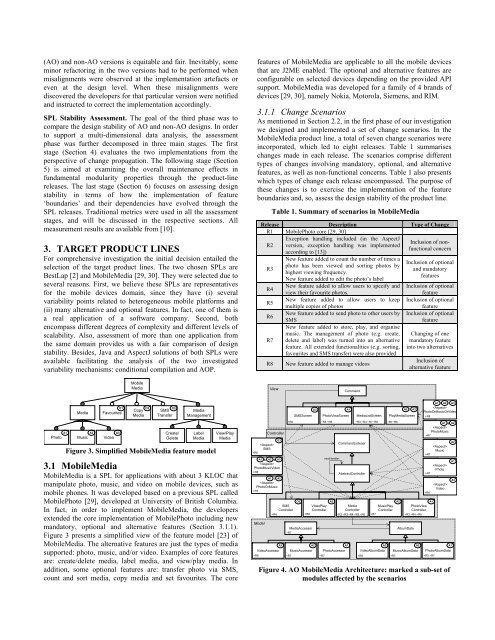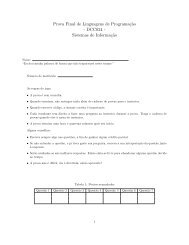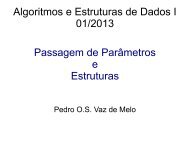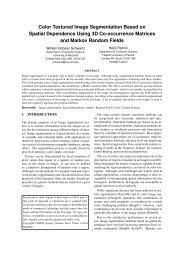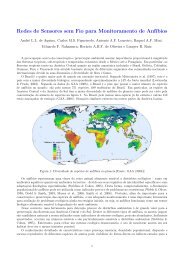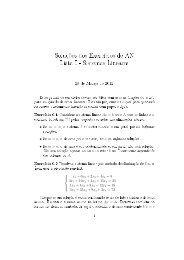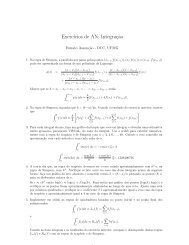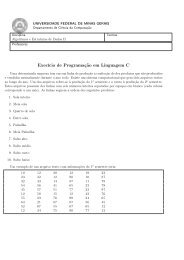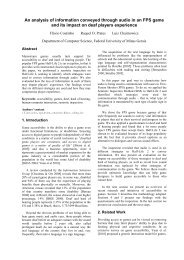Evolving Software Product Lines with Aspects: An Empirical ... - UFMG
Evolving Software Product Lines with Aspects: An Empirical ... - UFMG
Evolving Software Product Lines with Aspects: An Empirical ... - UFMG
Create successful ePaper yourself
Turn your PDF publications into a flip-book with our unique Google optimized e-Paper software.
(AO) and non-AO versions is equitable and fair. Inevitably, some<br />
minor refactoring in the two versions had to be performed when<br />
misalignments were observed at the implementation artefacts or<br />
even at the design level. When these misalignments were<br />
discovered the developers for that particular version were notified<br />
and instructed to correct the implementation accordingly.<br />
SPL Stability Assessment. The goal of the third phase was to<br />
compare the design stability of AO and non-AO designs. In order<br />
to support a multi-dimensional data analysis, the assessment<br />
phase was further decomposed in three main stages. The first<br />
stage (Section 4) evaluates the two implementations from the<br />
perspective of change propagation. The following stage (Section<br />
5) is aimed at examining the overall maintenance effects in<br />
fundamental modularity properties through the product-line<br />
releases. The last stage (Section 6) focuses on assessing design<br />
stability in terms of how the implementation of feature<br />
‘boundaries’ and their dependencies have evolved through the<br />
SPL releases. Traditional metrics were used in all the assessment<br />
stages, and will be discussed in the respective sections. All<br />
measurement results are available from [10].<br />
3. TARGET PRODUCT LINES<br />
For comprehensive investigation the initial decision entailed the<br />
selection of the target product lines. The two chosen SPLs are<br />
BestLap [2] and MobileMedia [29, 30]. They were selected due to<br />
several reasons. First, we believe these SPLs are representatives<br />
for the mobile devices domain, since they have (i) several<br />
variability points related to heterogeneous mobile platforms and<br />
(ii) many alternative and optional features. In fact, one of them is<br />
a real application of a software company. Second, both<br />
encompass different degrees of complexity and different levels of<br />
scalability. Also, assessment of more than one application from<br />
the same domain provides us <strong>with</strong> a fair comparison of design<br />
stability. Besides, Java and AspectJ solutions of both SPLs were<br />
available facilitating the analysis of the two investigated<br />
variability mechanisms: conditional compilation and AOP.<br />
Media<br />
A1 A2 A3<br />
Photo Music Video<br />
Mobile<br />
Media<br />
O1<br />
Favourites<br />
O2 O3<br />
Copy<br />
Media<br />
SMS<br />
Transfer<br />
Create/<br />
Delete<br />
Media<br />
Management<br />
Label<br />
Media<br />
Figure 3. Simplified MobileMedia feature model<br />
View/Play<br />
Media<br />
3.1 MobileMedia<br />
MobileMedia is a SPL for applications <strong>with</strong> about 3 KLOC that<br />
manipulate photo, music, and video on mobile devices, such as<br />
mobile phones. It was developed based on a previous SPL called<br />
MobilePhoto [29], developed at University of British Columbia.<br />
In fact, in order to implement MobileMedia, the developers<br />
extended the core implementation of MobilePhoto including new<br />
mandatory, optional and alternative features (Section 3.1.1).<br />
Figure 3 presents a simplified view of the feature model [23] of<br />
MobileMedia. The alternative features are just the types of media<br />
supported: photo, music, and/or video. Examples of core features<br />
are: create/delete media, label media, and view/play media. In<br />
addition, some optional features are: transfer photo via SMS,<br />
count and sort media, copy media and set favourites. The core<br />
features of MobileMedia are applicable to all the mobile devices<br />
that are J2ME enabled. The optional and alternative features are<br />
configurable on selected devices depending on the provided API<br />
support. MobileMedia was developed for a family of 4 brands of<br />
devices [29, 30], namely Nokia, Motorola, Siemens, and RIM.<br />
3.1.1 Change Scenarios<br />
As mentioned in Section 2.2, in the first phase of our investigation<br />
we designed and implemented a set of change scenarios. In the<br />
MobileMedia product line, a total of seven change scenarios were<br />
incorporated, which led to eight releases. Table 1 summarises<br />
changes made in each release. The scenarios comprise different<br />
types of changes involving mandatory, optional, and alternative<br />
features, as well as non-functional concerns. Table 1 also presents<br />
which types of change each release encompassed. The purpose of<br />
these changes is to exercise the implementation of the feature<br />
boundaries and, so, assess the design stability of the product line.<br />
Table 1. Summary of scenarios in MobileMedia<br />
Release Description Type of Change<br />
R1 MobilePhoto core [29, 30]<br />
R2<br />
Exception handling included (in the AspectJ<br />
version, exception handling was implemented<br />
according to [13])<br />
Inclusion of nonfunctional<br />
concern<br />
R3<br />
New feature added to count the number of times a<br />
photo has been viewed and sorting photos by<br />
highest viewing frequency.<br />
New feature added to edit the photo’s label<br />
Inclusion of optional<br />
and mandatory<br />
features<br />
R4<br />
New feature added to allow users to specify and<br />
view their favourite photos.<br />
Inclusion of optional<br />
feature<br />
R5<br />
New feature added to allow users to keep<br />
multiple copies of photos<br />
Inclusion of optional<br />
feature<br />
R6<br />
New feature added to send photo to other users by<br />
SMS<br />
New feature added to store, play, and organise<br />
Inclusion of optional<br />
feature<br />
music. The management of photo (e.g. create, Changing of one<br />
R7 delete and label) was turned into an alternative mandatory feature<br />
feature. All extended functionalities (e.g. sorting,<br />
favourites and SMS transfer) were also provided<br />
into two alternatives<br />
R8 New feature added to manage videos<br />
Inclusion of<br />
alternative feature<br />
+R6<br />
Controller<br />
<br />
SMS<br />
O3<br />
A1 & A2 & A3<br />
<br />
PhotoMusicVideo<br />
+R8<br />
A1 | A2<br />
<br />
PhotoOrMusic<br />
+R7<br />
Model<br />
View<br />
Command<br />
SMSScreen PhotoViewScreen MediaListScreen PlayMediaScreen<br />
nextHandler<br />
CommandListener<br />
AbstractController<br />
O3 A3<br />
A2<br />
A1<br />
SMS<br />
VideoPlay<br />
Media<br />
MusicPlay<br />
PhotoView<br />
Controller<br />
Controller<br />
Controller<br />
Controller<br />
Controller<br />
+R6<br />
+R8<br />
~R2 ~R3 ~R4 ~R5 ~R6 +R7<br />
+R3 ~R4 ~R5<br />
MediaAccessor<br />
~R7<br />
O3<br />
AlbumData<br />
A3 A2<br />
A1<br />
A3<br />
A2<br />
VideoAccessor MusicAccessor PhotoAccessor VideoAlbumData MusicAlbumData<br />
+R8<br />
+R6<br />
+R7<br />
~R5 ~R6<br />
~R7<br />
A1<br />
~R3 ~R4 ~R7~R8 +R7~R8<br />
+R8<br />
+R7<br />
A2 | A3<br />
A1 | A2 | A3<br />
<br />
PhotoOrMusicOrVideo<br />
+R8<br />
A1 & A2<br />
<br />
PhotoMusic<br />
+R7<br />
+R7<br />
+R7<br />
+R8<br />
<br />
Music<br />
<br />
Photo<br />
<br />
Video<br />
A2<br />
A1<br />
A3<br />
A1<br />
PhotoAlbumData<br />
+R5 ~R7<br />
Figure 4. AO MobileMedia Architecture: marked a sub-set of<br />
modules affected by the scenarios


